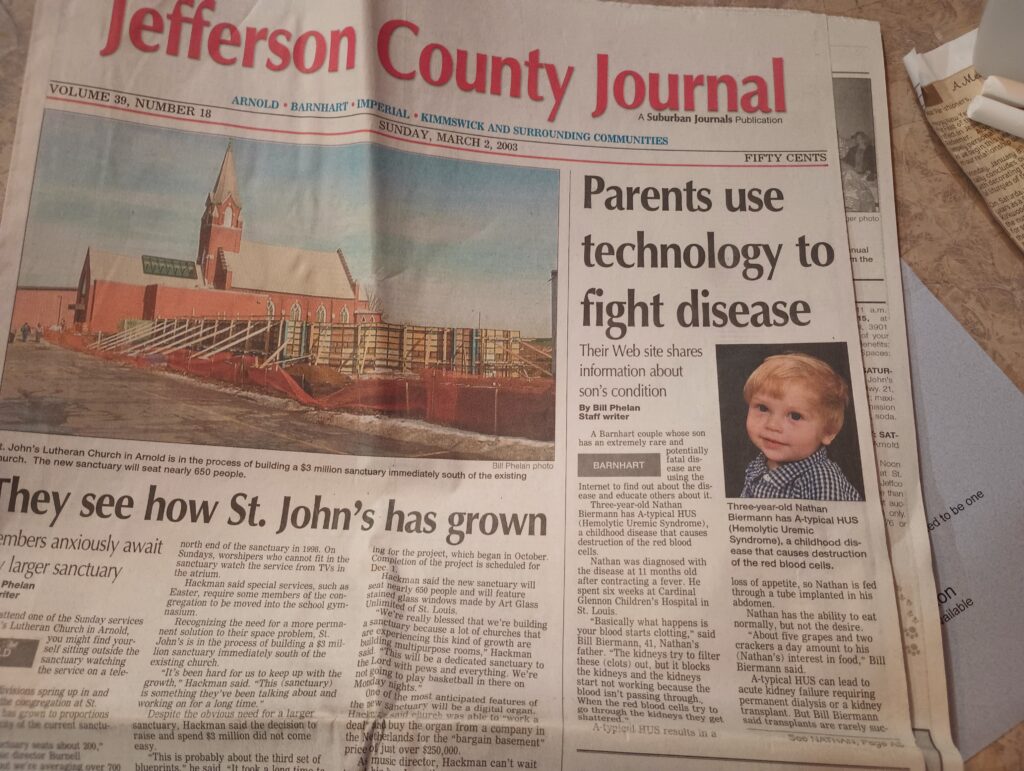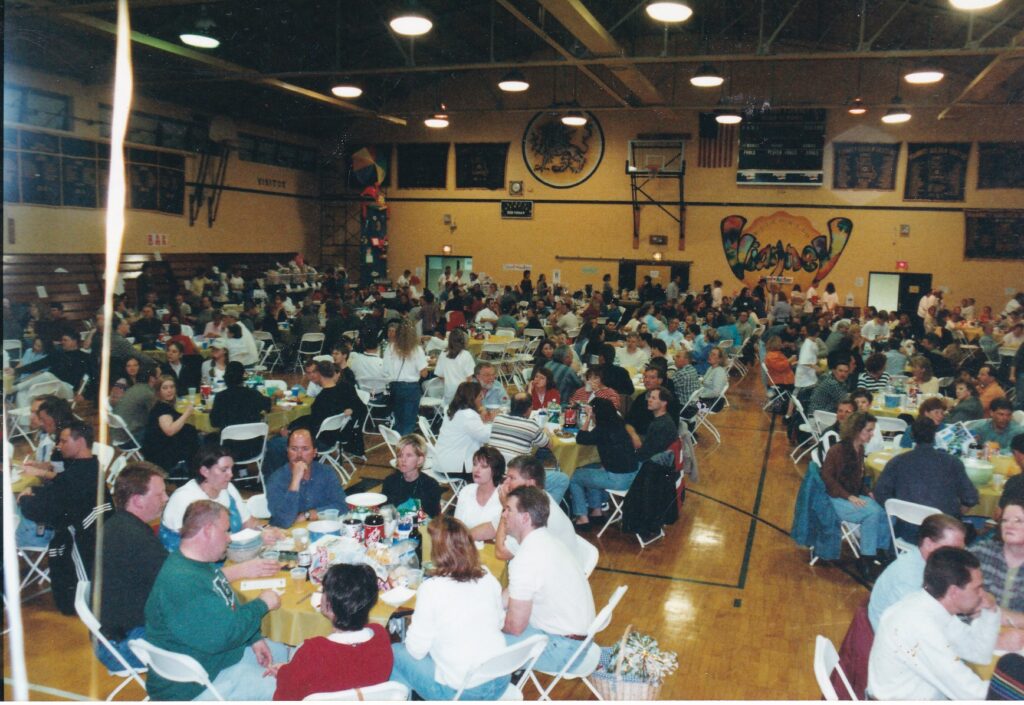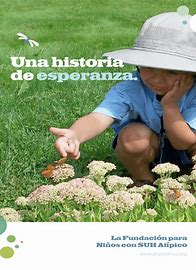The aHUS endeavours series continue with an interview with Bill and Cheryl Biermann whose family was affected by aHUS at the turn of the century.
Whilst coping with a family crisis, this couple decided to do something about the sparse information there was available about this rare disease at that time. To provide hope to others.
They created the first specific aHUS patient organisation and then they were the first to perform advocacy activities we now take for granted.
It is hard to imagine almost a quarter of a century on that there was a world where there was no aHUS patient information and no patient networking.
Global Action met with them and they told us about what they did.

Global Action: Why did you feel the need to enter aHUS patient advocacy and how did it start?
Bill and Cheryl: In late 2000 we were told our son Nathan had become ill with atypical aHUS or aHUS. He was not yet one year old. In that first year after becoming ill he had spent over 182 days in hospital getting plasma therapy to stave of kidney failure but still with slow decline in his kidney function. There was little that could be done about it, and we searched the internet for information about aHUS We started to look at research articles and Bill made contact with some European aHUS researchers like Dr. Peter Zipfel in Germany and Dr. Guiseppe Remuzzi in Italy who give us some advice. There was little or nothing else outside of academia.
GA: What happened next?
B&C: We decided just to do something, simple as that. In 2001 it was clear there was no one advocating for patients like our son, so we decided to build the first ever aHUS patient organisation.
GA: And you knew how to do that?
B&C: Well, no not really, so we started to look on the internet for others who were doing the same thing for other diseases. We came across a website for something called Dense Deposit Disease and spoke to its administrator, a lady called Lynne. She said that we needed a long-term goal. We saw funding research as the ultimate goal and finding an effective treatment. But that was for the future because it needed money, we had none, and a collaboration with an interested clinical research institution was needed too.
GA: An admirable aim 23 years ago. So, what could you do?
B&C: In 2001 we created an 501c3 organisation (a not for profit /charitable company) so that people would have confidence in our organisation as we would be fundraising. We also needed to have an internet presence; you must remember these were the early days of the internet. In late 2001 we moved quickly from one of those free sites that were available at the time to our own website with our own website domain.
GA: And what was the name of this organisation.
B&C: Well we had to have the word “Foundation” in it, and we made it about “children” because in those days the disease was regarded as a children’s disease. And from our contact with clinicians and researchers we used the name atypical HUS because that is what they called. So, we became the “Foundation for Children with Atypical HUS”. The first patient organisation dedicated to aHUS. And the website got the same title and became the first ever online source about aHUS patients. Our core objectives for both was to Outreach and Connect to build a network and also Educate. We wanted the organisation to be run by unpaid volunteers of likeminded people.
GA: “Children” that figures. Back then it was often called “HUS-TTP” and TTP was seen as the adult version. Even today annual children’s aHUS incidence rates are higher than adults, but there more adult aHUS patients. HUS is still a leading cause of kidney disease in children.
We digress. So after you built the organisation did people come?
B&C: Well yes. Remember these were the pioneering years of aHUS advocacy on the web. A Google search for “ aHUS” would find very little out there and our website soon became top of aHUS search results. Website views increased and soon more and more people began to make themselves known to us. From around the states and from Europe too.
GA: So, your computer skills really helped in the growth of the organisation.
B&C: Yes, it may be difficult for many people today to appreciate but it was all new to us and to users of the internet. I did understand how SEO worked on the internet, so I took advantage of that. Outreach and Connection aims could not have been done without it. Although conventional means of communication still worked. We spent a lot of time talking to people who had called us by telephone. And we did get into the local newspaper.

GA: That was probably the first article in the media about an aHUS patient. When did you have the first face to face meeting with aHUS families?
B&C: That was not until November 2007 in Iowa. 12 parents , the 12 Apostles you might say, met with Richard Smith and his team from the University of Iowa. Sessions were held to learn about aHUS and for people to talk about their children’s and their experience of aHUS. It was very cold in Iowa at that time of the year and there was blizzard like conditions outside the venue. So, it was memorable for different reasons, but it was the first aHUS patient conference.
GA: You mention a Richard Smith and Iowa University why did you hold your first meeting there?
B&C: Well, you recall we looked at models of patient advocacy organisations and we wanted to be the kind of patient organisation that raised funds to partner with a research group.
GA: Yes.
B&C: The year before we had met with Richard who was interested in aHUS and we talked about funding one of his graduates to do some aHUS research as we originally intended to do back when we started. Whilst we did not have the funds then and he was not ready to allocate a post graduate student, our relationship had begun. At that meeting we also discovered that Richard was Lynne’s husband. Lynne was the person we spoke to at the beginning of our advocacy, We did not know.
GA: Small world. So that important collaboration for research had to wait.
B&C: Oh no! Richard asked us to become a hub for distributing genetic testing kits to people who were contacting us. We sent them the kits and they sent the completed tests to Iowa for genetic testing. The test results were sent to patient/parents telling them for example whether their complement system has a mutation or not and which component was affected. But the data also helped Iowa’s aHUS research.
GA: Wow, you became actively involved in his aHUS research, the first collaboration between a patient organisation and a researcher.
B&C: Yes, we were already developing contacts with other clinical researchers. The two researchers from the early days. In 2004 we also met with Prof. Tim Goodship. He was visiting our city to talk at a nephrology convention and Bill had registered to attend it. During the Convention Bill managed to meet up with Tim who spent an hour talking to him and even introduced him to doctors at our city’s hospital who we had never met. Bill recalls vividly Tim writing something down on a piece of paper for him to watch out for. The words written were “complement inhibitor”. The Foundation was the first patient organisation to know about a potential treatment. At this time, we knew nothing about Alexion or whether they were aware of us as the only aHUS patient organisation in the world. It would be a while before that connection was made.
GA: Patient advocates attending a clinical convention was unusual how were you able to register for it?
B&C: The Foundation funded a booth in the exhibition part of the Convention, so we talked to a lot of delegates who were not aware of aHUS. When Tim came across our booth, he said he would never have thought he would see a booth about aHUS. Another first for the Foundation. We continued with having booths at nephrology conferences in the years that followed and parents we knew in the host city would represent the Foundation and raise aHUS awareness among clinicians.
GA: You said that by the time you met Richard you did not have enough funds to sponsor a student but having awareness booths at conferences would be costing you?
B&C: Yes, soon after we started in 2001, we began fundraising. There was little access to “educational grants” in those days. However, we did manage to fund research by Dr. Remuzzi in 2004 and Dr. Zipfel shortly after. Our first fundraising event was in our home city. Over 400 people attended a “Trivia Night” and donated to our organisation. Our family and friends and strangers really gave us great support. A lot of work but these became annual events sometimes more than once a year. Others joined in to host fundraisers elsewhere too.

GA: All this needs some time to do.
B&C: Yes typically we were spending 15 to 25 hours a week on aHUS matters while working full time and raising our young family including our son who had aHUS and who by late 2005 had reached end stage kidney failure and was on long term dialysis. This is what it is like for unpaid volunteer advocates with a determination.
GA: So other volunteers were needed?
B&C: Yes, very much so and people started to help us. Those standing at booths at conventions and others who would eventually take on responsibility for the Foundation, like Phyllis Talbot and Linda Burke. One of the best examples of the volunteers working together was our booklet , “A story of hope” , which features tales about aHUS children and adult patients.
Note it is still available today click on the link to see ahus-stories-of-hope.pdf (rareconnect.org)

It was published in several languages too.
GA: Another first, a booklet about living with aHUS. I remember referring people to it on the UK aHUS website. It saved us doing something similar. Linda Burke is now a stalwart of Global Action.
B&C: Yes, and we cannot think of anyone better suited to work at a global level for aHUS people. She helped us out with our website. We had upgraded the original website a couple of times over the years, but Linda and her family took it to a new level for us. We kept both websites going in parallel, our first site and the “NING” site which began to get more of a following because of its “interactive” nature thanks to Linda.
GA: Agreed the NING website was a pioneering endeavour in its own right?
So, you were fundraising , raising the aHUS profile on the internet and medical conference including a patient conference , networking with clinicians. Meeting your core objectives of outreach, connection and education but when did you meet your aim of funding research at Iowa.
B&C: It was 6 years after we started and by 2008, we had raised enough money and Richard Smith allocated a research graduate that we could help pay for. By the 2010s the Iowa aHUS Patient Conferences had become biannual events and attendance numbers grew with families travelling from all over the states and even from abroad. Richard and his team would spend a day telling delegates about aHUS and the aHUS research they were conducting. There was also social aspects to the event so that families could swap tales of their experience and build lasting friendships. A model for aHUS patient meetings of the future to follow All that we wanted to do at the start of our advocacy was now happening in front of our eyes. Our son had a kidney transplant in 2011, 10 years after it all started, he was among the first to get a transplant supported by eculizumab.
GA: And what about eculizumab ( Soliris)
B&C: It was Linda who first brought the drug to our attention. It was to become one the most visited part of the website, we were the first to give information about it. Thousands of website visitors from around the world came to find out about the drug. It was also at that time that Alexion connected with us.
GA: So, when did you decide to bow out from the Foundation you had created.
B&C: By 2014 others began to take on the lead roles in the Foundation that we had carried out for over 13 years . It was time to hand it all over to others to carry forward. We attended our last conference in Iowa in 2014 . By the next conference all had changed, the directors of the 501c3 were different, the name of organisation had changed and the original websites would go dark to be replaced by a new version. A new era had begun. Full of the hope that we wanted to bring to others like us. We “retired” though Cheryl still contributes on the aHUS Families Facebook Group from time to time.
GA: Well it was all due to your pioneering efforts. The Foundation had become a “go to place” for aHUS people and a “begin with model” for other national aHUS organisations to follow. Those who were around in those days know what you brought to the Global aHUS community . Things may be different going forward but there will not be the “firsts” that you both achieved in aHUS patient advocacy back when there was none.
And before we end how is Nathan – the boy who started it all- today?
B&C: Nathan is doing quite well and recently switched to ravulizumab. He received his transplant from Cheryl and often jokes “keep the other kidney in good working order I might need that one day”. Nathan now turned 24 years and is going back to school, He plans to start school in the summer and learn CNC machining technology.
GA: That is so good to hear. Thanks, Bill and Cheryl, for all you have done.
Article No. 650.

